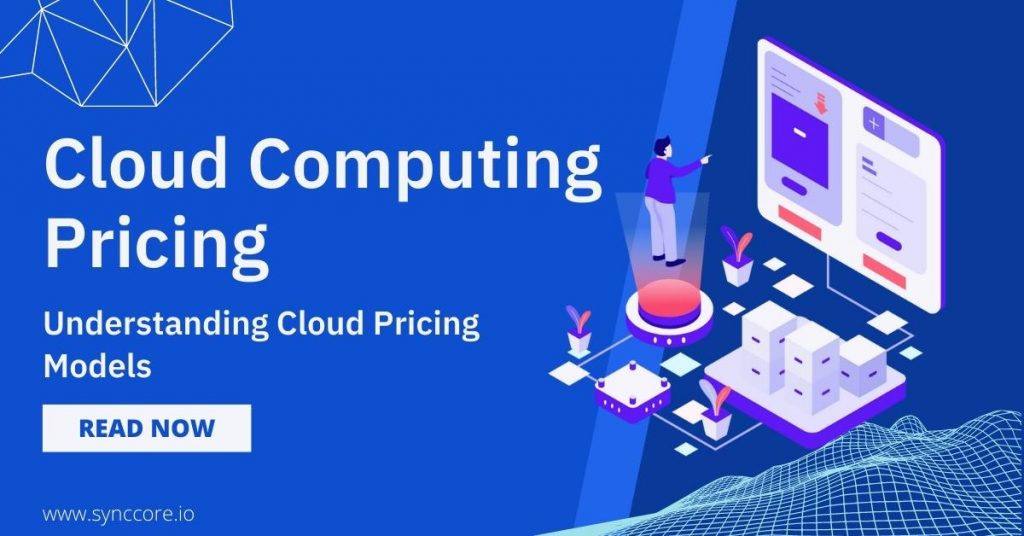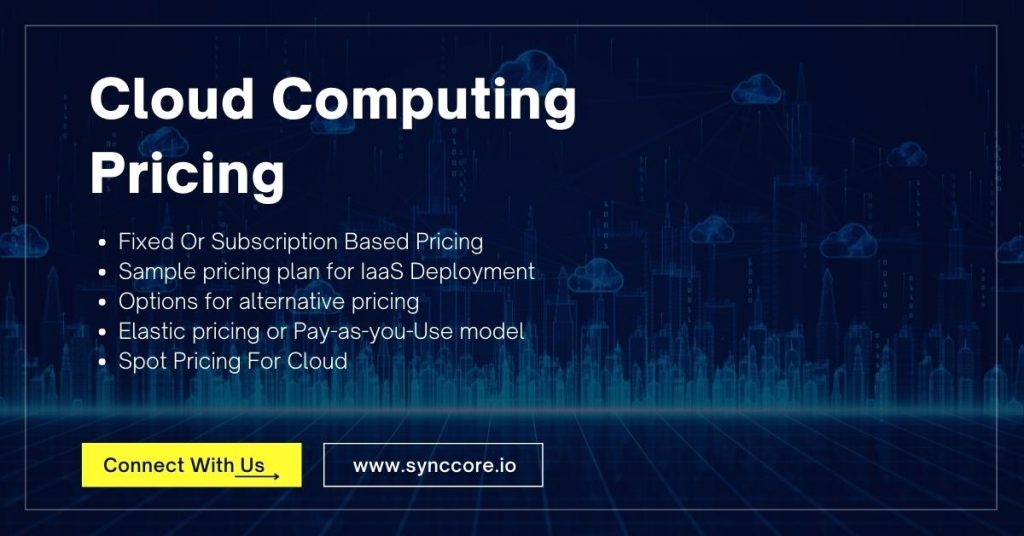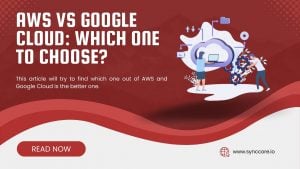Table of Contents
Cloud Computing Pricing

Fixed Or Subscription Based Pricing:
The most basic option is fixed regular pricing, in which the customer organization is billed monthly. A virtual machine, for example, can be offered at a fixed monthly cost. The consumer is billed the same monthly amount, regardless of actual usage.
Virtual machines are available in this plan at both a monthly and hourly rate. Bandwidth is priced based on the amount of data transferred or fixed bandwidth plans. Some services, such as data encryption and backups, are priced in terms of GB of data. SLAs are calculated as a factor of the base virtual machine rates.
Sample pricing plan for IaaS Deployment
Another option is to provide tier pricing based on the volume of services consumed, with “unlimited” as the most extensive available unit.
A recent Ernst & Young survey on Cloud Computing adoption in India revealed the following findings:
Most respondents who prefer an annual contract-based model are large enterprises, whereas most SMB respondents prefer the resource-based usage model.
At this point, a single pricing model is unlikely to satisfy all potential market customers. Vendors must have pricing structures that are simple to understand, transparent, and provide significant cost savings.
Options for alternative pricing models are:
The SMB market will be drawn to an accurate pay-as-you-use model based on resource utilization, such as per-hour usage or CPU cycles consumed.
Server instances can be billed daily or monthly rather than hourly, using more flexible models that integrate usage-based and contract-based pricing features.
For larger businesses with visibility on demand, reserved instances with savings on hourly prices may be more affordable. Large companies may find that reserved instances make predicting and planning for cloud IaaS requirements easier.
Elastic pricing or Pay-as-you-Use model
Customers are billed for cloud services according to their usage and consumption under flexible pricing. Since the cost comes from the users’ pockets or, in the case of enterprises, their budgets, a flexible pricing system makes consumers aware of the cost of conducting business and consuming a resource. Additionally, when people are aware of the prices, they use resources more wisely and efficiently, which reduces waste and lowers expenses.
Spot Pricing For Cloud
As for Amazon.com introducing a spot market for its EC2 services, the concept of market-based pricing takes on new meaning in cloud business models. The spot-pricing model is governed by market forces, which means that when computing and storage resources are in high demand, the spot market will drive up the price of services. When resources are in short supply, the spot market drives the price down, creating opportunities for bargain hunters.
Cloud Chargeback
Chargeback is a term used in IT (cloud computing) that refers to the cost charged to organizations for using cloud computing services: making the consumer pay for the usage.
A chargeback model in the cloud delivers many benefits, including:
- Connecting usage to cloud consumers or corporate departments so users can be charged if desired.
- Giving insight into resource utilization.
- Making capacity planning, forecasting, and budgeting easier.
- As an incentive, encouraging the use of emerging technologies may be priced lower than other services (For example, virtual machines will cost less than physical servers).
- Transparency in enterprise IT is critical in transforming enterprise IT from a cost center to a business enabler.
- Providing a mechanism for enterprise IT to justify and allocate costs to their stakeholder business units.
A cloud service provider must consider the chargeback model when designing a chargeback service.
- Components can be easily scaled to handle cloud-sized workloads.
- Simple to modify to handle pricing variations, such as promotions and specials that may vary over time or by region.
- To handle billing inquiries and disputes and keep and retrieve detailed records on all charges.
- Charges for actual resource usage must be assessed accurately and completely.
The methodology for defining and deploying a chargeback service applies to private, public, and hybrid clouds.

According to Gartner. Almost all corporations, organizations, and governmental agencies will use the cloud within five years. This is because the cloud provides much-needed agility not only for IT but also for the entire business, allowing organizations to focus on strategic business issues. The cloud also enables companies to realize significant cost savings by converting capital investments to operating expenses.
Reduced product lifecycle, aggressive time to market, increasing the risk of technology obsolescence, the proliferation of new devices, applications becoming more resource intensive, increase in mobile forces, and the organizational need to focus on core competencies are driving cloud technology adoption. Most importantly, these developments portend a shift in the role of IT within the enterprise toward becoming a true business partner.
The three different service models for cloud computing delivery, IaaS, SaaS, and PaaS, enable enterprises to mix and match the best service model to their organization’s business needs based on requirements and payment options. The availability of cloud infrastructure options, such as private, public, and hybrid models, allows enterprises to select the best cloud technology based on the vertical industry, regulatory requirements, risk tolerance, and specific application portfolio.
Cloud Service Providers must understand the buyer (business or IT decision maker) for their cloud services to tailor their pricing models to buyer preferences. Some providers will discover that their brand and reputation allow them to price based on the value delivered by their services rather than purely on hourly usage rates. The challenge is determining how to quantify and capture this value through pricing. Strategic customers will command better pricing and higher service levels in the future.
Cloud providers have their work cut out in simplifying pricing models, beefing up security, and providing SLAs that guarantee better reliability. The market is changing quickly, and today’s dominant players may be obsolete in a quarter!
If you require cloud services, please contact us at [email protected] or visit our website at www.synccore.io.
Read More:
Cloud Computing Business Agility: How the Cloud Can Increase Your Business Agility
Cloud Services for Business Continuity and Disaster Recovery



